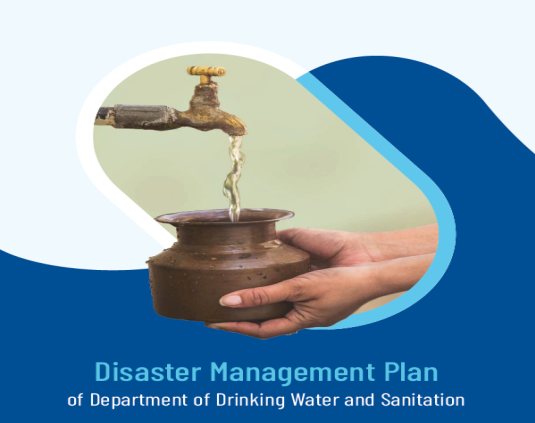The Union Minister for Jal Shakti, Shri Gajendra Singh Shekhawat released the Manual for Disaster Management Plan (DMP) during the two-day national conference of Rural WASH Partners Forum at Vigyan Bhawan in New Delhi which culminated on 22, July 2023. The Manual is developed by Department of Drinking Water and Sanitation to ensure safety, uninterrupted supply and minimum loss of Water, Sanitation and Hygiene (WASH) assets and services involving stakeholders at national, state, district, and village level. The Plan aligns with the two-flagship programmes on WASH implemented by the Department namely the Jal Jeevan Mission (JJM) and Swachh Bharat Mission-Grameen (SBM-G).
The Disaster Plan is developed based on the Advisory issued by National Disaster Management Authority (NDMA) which, under Section 37 of Disaster Management Act, 2005 desires every Ministry/ Department to develop its own disaster plan to counter and be prepared for any emergency arising in future. The objective of the Plan is to ensure immediate WASH response to disasters as per the agreed standards; enhance WASH resilience to reduce disaster vulnerability; establish a robust environment, fund and coordination mechanism to achieve the desired goals; and develop a plan which caters to disaster preparedness, response, recovery, reconstruction, and mitigation.
The document developed by the Department looks into the vulnerability of WASH assets and services under different types of disasters, impact of disaster on WASH infrastructure and services, disaster management cycle and activities for disaster-resilient WASH infrastructure construction at all stages, institutional mechanism for disaster preparedness, response, recovery, reconstruction, mitigation at various levels, minimum standards for WASH service delivery during and post-disaster and financial mechanism to fund the integration of disaster-resilience in WASH assets and services. This disaster management plan includes, Gender-based vulnerabilities, issues concerning Scheduled Castes and Scheduled Tribes (SC/ST), elderly, children and people with disabilities.
According highest priority to the issue of disaster recovery the Manual offers a holistic approach addressing community preparedness, technology use, and international cooperation. The document focuses on four stages of planning – preparedness, response, recovery & reconstruction and mitigation apart from addressing the issues as per the 10-point agenda for risk reduction. In case of disaster, three kinds of assessment need to be conducted
1. Before the disaster: A Hazard-Vulnerability-Capacity mapping to guide the preparedness activities most needed,
2. During Response: A Rapid Needs Assessment (RNA) which can be completed in a day and point out the immediate needs of the affected population,
3. During Recovery & Reconstruction: A detailed Post-Disaster Needs Assessment (PDNA) which highlights the long-term needs of the community and helps the administration “build back better” the damaged infrastructure and update the service delivery mechanisms to mitigate against future disasters.
It is envisaged that the Manual shall provide clear guidance to States and Districts for planning of disaster risk reduction, disaster preparedness and for undertaking prompt and efficient efforts for disaster recovery.

No comments:
Post a Comment